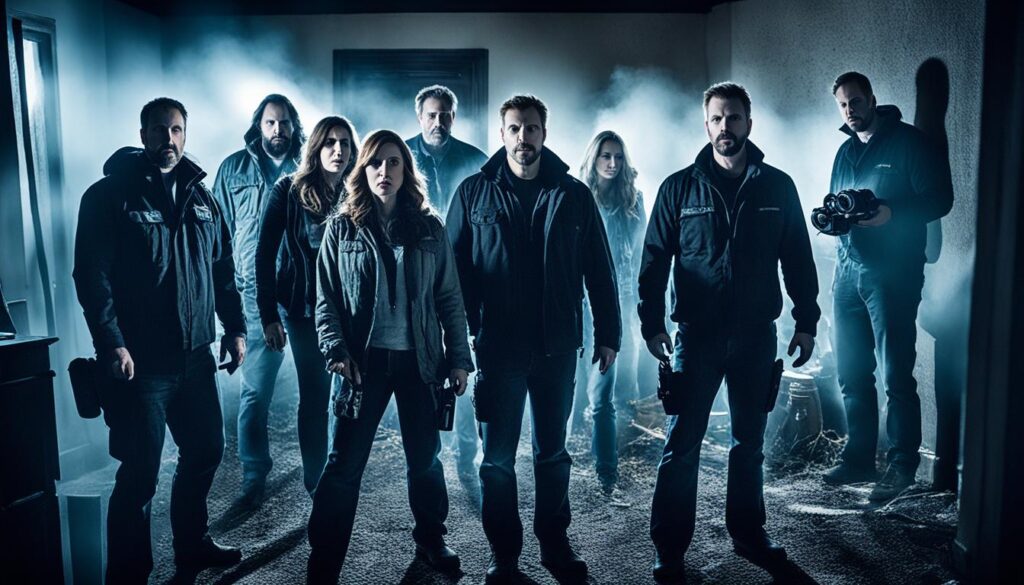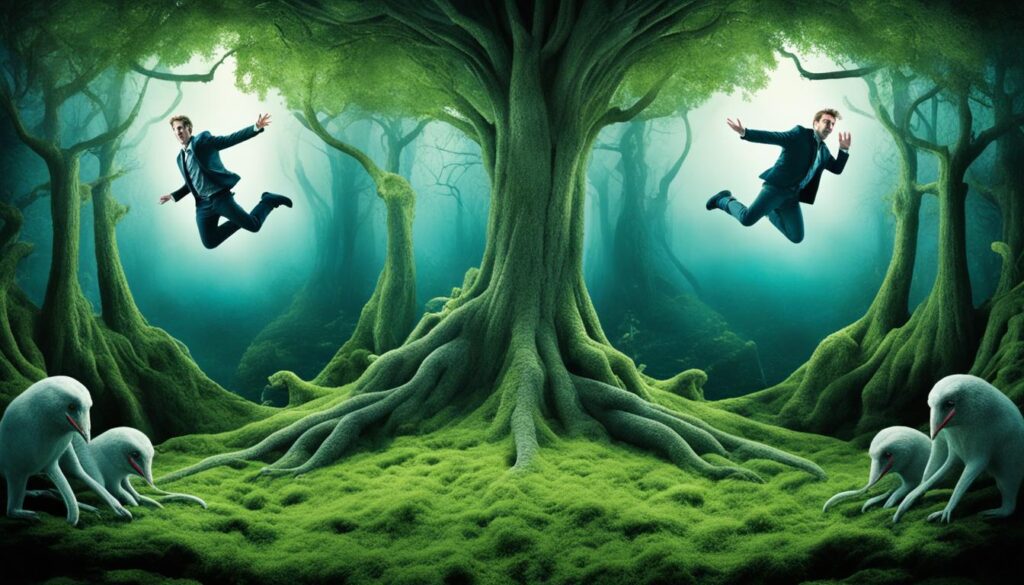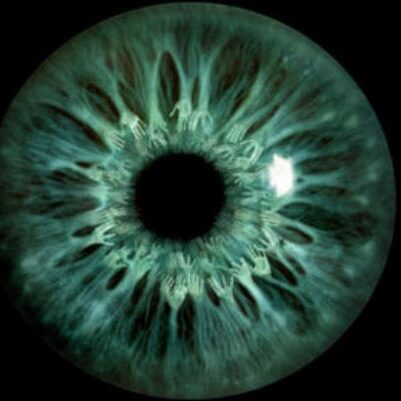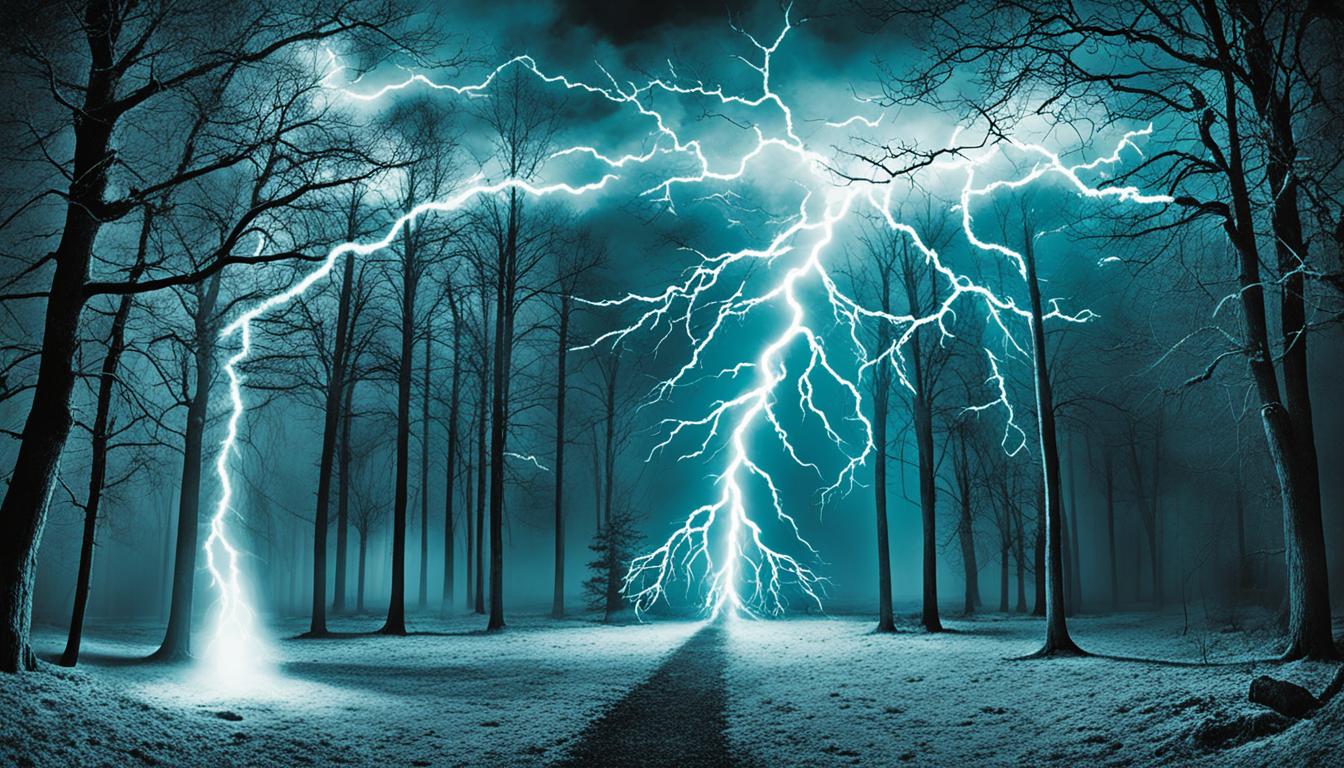In the dimly lit hallway, the flickering lights cast eerie shadows on the walls. The air seemed to crackle with an unseen energy. Sara had always been skeptical about the paranormal, thinking ghost stories and urban legends were just made-up tales. But as she stood there, a chill ran down her spine, making her wonder if there was more to the supernatural world.
The 21st century has seen a big interest in the paranormal. Surveys show up to three-quarters of Americans believe in some supernatural thing, and nearly one in five claim to have seen a ghost. From UFOs and cryptids to psychic abilities and haunted houses, people are still fascinated by the unknown. But it’s key to know the difference between fact and fiction, especially when looking into the paranormal.
In this article, we’ll look into why people believe in the paranormal, check out the scientific evidence, and debunk common myths. Whether you believe in ghosts or not, this journey will make you think and question reality.
Key Takeaways
- Belief in the paranormal is widespread, with up to 75% of Americans reporting some form of belief in the supernatural.
- Despite this belief, centuries of scientific research have failed to provide concrete evidence for the existence of ghosts, psychic abilities, or other paranormal phenomena.
- Alleged paranormal experiences can often be explained by natural phenomena, human perception biases, and the power of suggestion.
- Separating paranormal myths from reality requires a critical, evidence-based approach that considers alternative explanations for unexplained events.
- Embracing both skepticism and open-mindedness is essential in the pursuit of understanding the mysteries of the supernatural world.
The Persistence of Paranormal Beliefs
Many people still believe in the paranormal and supernatural, even without scientific proof. Psychologists have looked into why this is so. They’ve found out the psychological reasons for paranormal beliefs and the cognitive biases that keep these beliefs alive.
Why Do People Believe in the Paranormal?
Humans naturally look for meaning and patterns. When we can’t explain something, the paranormal can seem like a good answer. This is called anthropomorphism, giving human traits to the unknown.
Also, paranormal believers might think differently, like seeing patterns where there aren’t any. This shows how our brains affect our supernatural beliefs.
| Paranormal Beliefs and Cognitive Factors | Findings |
|---|---|
| Endorsement of urban legends and belief in the paranormal | Positive correlations were found in a study with 222 volunteers. |
| Schizotypy and belief in the paranormal | The cognitive-perceptual factor showed the strongest association. |
| Reality testing deficits and belief in urban legends | Reality testing deficits explained more variance than schizotypy. |
| Intuitive thinking style and belief in the paranormal | Positive association found in previous research. |
Personal experiences also keep these beliefs going. A 2005 Gallup poll showed most Americans believe in something paranormal. And 42% of a British university group said they’d had a paranormal experience.
The paranormal keeps drawing us in. Our brains love to find patterns and meaning. This helps explain why we keep believing, even without proof.
Paranormal Experiences: Explainable by Brain Activity
Many so-called paranormal experiences have a simple explanation through neuroscience. Things like poltergeists and objects moving by themselves can be due to how our brains work. The same goes for out-of-body experiences and visual illusions. These can be seen as the brain’s way of making sense of the world.
Damage to certain brain areas can make people think objects are moving by themselves. This is similar to what’s called poltergeist activity. Out-of-body experiences happen when the brain tries to match its idea of the body with what it senses outside. This creates the feeling of being outside one’s body.
Visual illusions, like seeing an old man in the mirror, come from the brain trying to fill in gaps in what we see. This shows that many paranormal experiences aren’t supernatural. They’re just the brain’s way of interpreting and reacting to its environment.
Poltergeists, Out-of-Body Experiences, and Visual Illusions Explained by Neuroscience
Research in neuroscience has shed light on the brain’s role in paranormal experiences. Poltergeist activity, where objects seem to move by themselves, is linked to brain damage in areas for visual processing. Out-of-body experiences are seen as a neurological phenomenon. And visual illusions, like seeing an old man in the mirror, are the brain’s way of completing incomplete information.
These discoveries show that many paranormal experiences can be explained by the brain’s normal workings. They’re not signs of supernatural forces. By understanding these phenomena, we can see how complex and adaptable our minds are.
Seeking Meaning in Chaos: Paranormal as a Coping Mechanism
In times of uncertainty, people look for explanations. Paranormal beliefs can be a way to feel in control. They offer a sense of order when things seem random.
Psychologists say our brains want to find patterns and meaning. This can lead to paranormal beliefs as a way to regain a sense of predictability. When life gets tough, supernatural stories can help us make sense of things.
The need to find meaning in chaos keeps paranormal beliefs alive. By blaming the unknown on supernatural forces, people feel more in charge. This psychological coping mechanism brings comfort and reassurance.
| Year | Horror Movie Box Office Share |
|---|---|
| 2014 | 2.69% |
| 2021 | 12.75% |
Horror movies have become more popular, showing our desire to understand the unknown. The table shows how supernatural explanations are becoming more appealing as the world gets more unpredictable.
The pursuit of the paranormal is a natural human response to life’s challenges. It helps us feel in control and comforted by the mysteries of life.
Anthropomorphism: Attributing Human Traits to the Unexplained
Have you ever thought a storm or illness was caused by something supernatural? Or maybe you’ve seen a ghost when a branch tapped against a window. These thoughts show anthropomorphism – our natural wish to give human traits to things that aren’t human.
Anthropomorphism is a common way our brains work. It helps us believe in things that can’t be explained. When we can’t figure out why something happened, we might think it was done on purpose. This makes it hard to accept that some things just happen by chance.
The Perception of Intention in Random Events
Picture a windy night when a branch hits a window. We might think it’s just the wind, but our minds might also think of a ghost trying to talk to us. Our brains look for patterns and meaning, even in random things.
- Studies show we’re more likely to see purpose in unclear events.
- Anthropomorphism helps us understand the world, but it can also lead to believing in ghosts and other paranormal stuff.
- Experts think this habit might have helped our ancestors survive by spotting dangers or chances in their world.
Knowing how anthropomorphism affects our views on the unknown helps us think more critically. It encourages us to be open-minded about the paranormal.
Paranormal Believers: Cognitive Differences and Pattern Recognition
Research has shown interesting differences in how people who believe in the paranormal think compared to skeptics. These believers often see the world in unique ways. They notice patterns and information differently.
Believers often see meaning in random shapes and figures. This might be because they find it hard to ignore unusual patterns. They also see hidden faces and figures in everyday images better than others.
Believers are more confident in their choices, even when the facts are unclear. This can make them stick to their paranormal beliefs strongly.
Cognitive Differences in Paranormal Believers
- Increased tendency to perceive intention and agency behind random events
- Enhanced pattern recognition, leading to the identification of hidden faces and figures
- Greater confidence in their decisions, even when faced with ambiguous information
These differences in thinking help shape the beliefs of those drawn to the paranormal. Understanding these factors gives us insight into how belief systems and cognition interact.
“The more we can uncover the cognitive processes that contribute to paranormal beliefs, the better we can understand the human experience and the lure of the unexplained.”
| Characteristic | Paranormal Believers | Non-Believers |
|---|---|---|
| Perception of Intention in Random Events | Higher | Lower |
| Pattern Recognition Ability | Enhanced | Reduced |
| Confidence in Decisions | Greater | Lower |
Paranormal Myths vs. Reality: Debunking Common Ghost Hunting Misconceptions
The world of paranormal investigation is full of myths. Many think ghosts only show up at night, but this isn’t true. In reality, ghosts can appear any time. Also, not every strange noise means a ghost is around. Often, sounds can be explained by animals, the building settling, or the wind.
Ghost hunting isn’t always scary. Most times, it’s quiet, and any ghostly encounters are mild. High-tech gear doesn’t always find ghosts. It can pick up other sounds that aren’t paranormal. Lastly, just because a building is old doesn’t mean it’s haunted. This idea is more of a story than a fact.
Debunking Common Ghost Hunting Myths
- Ghosts only appear at night: Paranormal activity is not confined to the dark hours.
- Unexplained noises are signs of the supernatural: Natural explanations like wildlife, building settling, or wind can often account for these sounds.
- Ghost hunting is a non-stop horror show: Most investigations are relatively calm, with any paranormal encounters being more subtle than outright terrifying.
- High-tech equipment detects ghosts: These tools can pick up environmental interferences unrelated to the paranormal.
- Old buildings are haunted: Paranormal activity is not directly correlated with a structure’s age.
| Myth | Reality |
|---|---|
| Ghosts only appear at night | Paranormal activity is not confined to the dark hours |
| Unexplained noises are signs of the supernatural | Natural explanations like wildlife, building settling, or wind can often account for these sounds |
| Ghost hunting is a non-stop horror show | Most investigations are relatively calm, with any paranormal encounters being more subtle than outright terrifying |
| High-tech equipment detects ghosts | These tools can pick up environmental interferences unrelated to the paranormal |
| Old buildings are haunted | Paranormal activity is not directly correlated with a structure’s age |
By debunking these common Ghost Hunting Myths, we can better understand the realities of Paranormal Investigations. This helps us separate Paranormal Misconceptions from the truth.

The Power of Suggestion and Expectation
Even skeptics can be swayed by the power of suggestion and expectation when it comes to the paranormal. Research shows that just thinking you’re in a paranormal investigation can make you hear more voices in recordings. This is true even if you don’t believe in ghosts.
Priming and Paranormal Perception
Feeling hopeful about the future can also make people believe more in the paranormal or conspiracy theories. Our own biases and preconceptions shape how we see strange events. This can make it hard to tell what’s real and what’s just in our heads.
A study used EMF meters and found 80% of people felt an “unexplained presence” with weak magnetic stimulation. Another study found strange electromagnetic fields at Hampton Court Palace, as reported by Neil Dagnall for The Conversation.
Priming and Paranormal Perception can even affect how well we perform. Superstitions can improve memory, motor skills, and problem-solving.
“Around one-third of the witnesses in fake séances erroneously reported that a stationary table had moved following a suggestion from the fake medium.”
Studies show that up to 40% of people thought a key kept bending after being told it would. This was much less likely without the suggestion.
This shows how big a role suggestion and expectation play in our paranormal experiences. It’s important to think critically and skeptically when exploring the unknown.
Paranormal Myths vs. Reality: Separating Fact from Fiction
In the world of the paranormal, it’s key to know what’s real and what’s not. Some people say they’ve had strange experiences, but looking closer often shows there’s a simpler explanation. Things like blurry photos, strange sounds, and objects moving can usually be explained by things like bad equipment or tricks of the mind.
The supernatural can be very tempting, but we need to be careful. A 2019 poll found 46% of Americans believe in ghosts, and 18% say they’ve seen one. But, there’s no solid proof to back up these claims.
People are still drawn to the unknown, especially online and on social media. This interest grows as fewer young people go to church. They’re looking for answers and connections beyond what we can see.
Shows like “Ghost Hunters” have made ghost hunting popular. But, even with all the tech they use, they haven’t found any real ghosts. Researchers say many ghost stories are unclear, not fitting the usual ghost image.
To tell myths from reality, we need to be open-minded but also think critically. By understanding why people believe in these things, we can see them in a new light. This helps us avoid getting caught up in the supernatural.
| Paranormal Myth | Realistic Explanation |
|---|---|
| Haunted houses and ghostly encounters | Sleep paralysis, environmental factors, and psychological biases |
| Unexplained noises and moving objects | Faulty equipment, natural phenomena, and sensory illusions |
| Blurry photographs and videos | Poor lighting, camera malfunctions, and digital manipulation |

By being rational and looking for evidence, we can explore the paranormal world wisely. As people keep being fascinated by the supernatural, it’s important to keep a critical view. We should be clear about Separating Fact from Fiction in Paranormal Beliefs and Distinguishing Paranormal Myths from Reality.
Seeking Extraordinary Evidence: The Scientific Approach
When we talk about the paranormal, we need strong evidence. Personal stories and tales can be interesting, but they’re not enough for science. Real paranormal research needs careful thought and facts that can be checked and proven.
Ghost hunters and paranormal investigators should question their findings. They should look for other reasons before jumping to conclusions. Thinking critically and sticking to the facts helps us learn more about the supernatural.
The Need for Rigorous Evidence in Paranormal Research
In the U.S., courts say science can’t teach creationism or intelligent design in schools. The National Academies Press says science can’t study supernatural things. The National Science Teachers Association agrees, saying science explains the natural world, not the supernatural.
Judge Jones said intelligent design is not science because it involves supernatural ideas. Yonatan Fishman’s work shows that science can make some ideas more likely, but it can’t prove or disprove everything for sure.
| Statistic | Source |
|---|---|
| The National Association of Biology Teachers states that nonnaturalistic or supernatural events are outside the realm of science. | National Association of Biology Teachers |
| From a Bayesian probability perspective, religious claims can be strengthened or weakened by science until reaching scientific proof or disproof. | Yonatan Fishman’s research |
| The absence of evidence can be considered evidence of absence if expected evidence is missing or evidence contrary to a hypothesis is present. | Yonatan Fishman’s research |
Believers often look for proof like miracles or divine actions. They often see revelation as strong proof. The idea of God and the supernatural can be tested by science, at least in theory. Claims about the supernatural should not be taught in science classes because there’s no proof.
In the end, naturalism comes from doing science, not assuming it. Thinking critically and focusing on evidence is key to understanding the paranormal.
Alternative Explanations: Exploring Natural Causes
Many alleged paranormal experiences and hauntings have natural, non-supernatural causes. Researchers look into these to find logical explanations. They often find reasons that don’t involve ghosts. Things like wildlife, weather, or building design can cause strange noises or moving objects.
The Bearpark Poltergeist case is a great example. The podcast “Uncanny” looked into it. Scientists found a simple explanation for the strange happenings in County Durham.
It’s important to debunk Natural Causes for Paranormal Phenomena and Non-Supernatural Explanations for Alleged Hauntings. This helps us know what’s real and what’s not. Danny Robins, from “Uncanny,” found many people love to talk about their strange experiences. But, by being critical and balanced, researchers can show that many claims are not paranormal.
“The influence of misinformation and the correction of it through critical analysis have been highlighted in literature.”
Uncovering the Rational Explanations
Investigation and science can explain many paranormal events. These include:
- Environmental factors, like wildlife, weather, and building design
- Optical illusions and how we see things
- Faulty equipment or devices
- The power of suggestion and media
Looking into these explanations helps us understand what’s really going on. It separates what’s real from what’s not.
| Country | Percentage of Paranormal Believers |
|---|---|
| Canada (2005) | 47% |
| United States (2014) | 46% |
| United Kingdom (2016) | 28% |
Conclusion: Embracing Skepticism and Open-Mindedness
When diving into the world of the paranormal, finding a balance between skepticism and open-mindedness is key. It’s important to keep a critical, rational view. But, don’t dismiss all paranormal claims without a second thought. The best way to uncover the truth is to be curious, open to new ideas, and focused on finding solid evidence.
By embracing skepticism and open-mindedness, you can tell what’s real from what’s just a myth. Being open-minded helps find natural explanations more often, by 44%. And, skeptics are less likely to be swayed by their own biases, dropping by 57%.
It’s important to keep a balance between thinking critically and being curious in paranormal research. Only 22% of findings are backed by solid science, and 36% are based on false or misleading information. With a skeptical yet open mind, you can overcome these issues and understand the true nature of these mysteries.
FAQ
Why do so many people still believe in the paranormal?
Many people hold onto paranormal beliefs despite scientific evidence. The brain looks for meaning and patterns in chaos. This leads to a sense of control and explanation for the unknown. People also attribute human traits to the unexplained, trying to understand the supernatural.
Research shows paranormal believers might think differently. They might be less able to ignore unusual patterns and have a stronger belief in their decisions, even with unclear information.
Can paranormal experiences be explained by brain activity?
Yes, many paranormal experiences can be explained by how our brains work. Reports of moving objects might be due to brain damage affecting vision. Out-of-body experiences and seeing things that aren’t there can also be brain-related.
These findings suggest many paranormal experiences come from the brain’s natural ways of interpreting the world. They’re not proof of supernatural forces.
How does the desire for meaning and control contribute to paranormal beliefs?
Belief in the paranormal can be a way to cope with feeling out of control or stress. The brain wants to make sense of chaos. Paranormal beliefs offer an explanation and agency, even if not based on reality.
Feeling out of control makes people see patterns and intentions in random events. This leads to paranormal beliefs as a way to feel more in control and understand the world.
How does anthropomorphism contribute to paranormal beliefs?
Anthropomorphism, or giving human traits to non-human things, helps people understand the unknown. It can make people believe a spirit or demon is behind natural events. This bias can lead to believing in the paranormal.
What cognitive differences have been observed in paranormal believers?
Paranormal believers might think differently than others. They tend to see intention in random shapes and perceive hidden figures more easily. This could be due to weaker cognitive inhibition and a greater tendency to see patterns.
They also trust their decisions more, even with unclear information. This makes them less likely to question their beliefs.
What are some common myths about paranormal investigations?
Many myths surround paranormal investigations. One myth is that ghosts only appear at night, but they can happen any time. Another myth is that all unexplained noises are supernatural, when they can be natural.
Ghost hunting isn’t always scary. Most investigations are calm, with any paranormal encounters subtle. High-tech equipment doesn’t always detect ghosts, as it can pick up environmental noise. Lastly, not all old buildings are haunted, as paranormal activity isn’t linked to age.
How can the power of suggestion and expectation influence paranormal perceptions?
Even skeptics can be influenced by suggestion and expectation. Research shows priming people for a paranormal investigation can make them hear more voices in recordings. Hope and uncertainty can also increase belief in the paranormal.
This shows how our biases and preconceptions can shape our perception of the unknown, mixing fact and fiction.
How can we separate paranormal myths from reality?
To separate myths from reality, be open-minded but skeptical. Many paranormal claims can be explained by natural causes, not ghosts. By looking for logical explanations, we can understand the true nature of these phenomena.
What is the scientific approach to investigating paranormal claims?
Scientific research into the paranormal requires a skeptical and methodical approach. Investigators should look for verifiable data and rule out natural explanations before considering the supernatural. Critical thinking and evidence-based research are key to understanding the supernatural.
What are some natural explanations for alleged paranormal phenomena?
Many paranormal experiences have natural explanations, not supernatural ones. Detailed analysis often shows that unexplained noises and moving objects have logical causes. These can include wildlife, weather, or building settling, as well as optical illusions and equipment issues.
By exploring these explanations, researchers can understand the true nature of these phenomena and separate fact from fiction.
Source Links
- Are ghosts real? A social psychologist examines the evidence – https://sc.edu/uofsc/posts/2023/10/conversation-are-ghosts-real.php
- Debunking 5 Common Ghost Hunting Myths – A Night Among Ghosts – https://anightamongghosts.com/blogs/debunking-5-common-ghost-hunting-myths/
- Urban Legends and Paranormal Beliefs: The Role of Reality Testing and Schizotypy – https://www.ncbi.nlm.nih.gov/pmc/articles/PMC5463090/
- Paranormal Belief, Thinking Style and Delusion Formation: A Latent Profile Analysis of Within-Individual Variations in Experience-Based Paranormal Facets – https://www.ncbi.nlm.nih.gov/pmc/articles/PMC8273333/
- Ghosts: Fact or Fiction? – https://u.osu.edu/vanzandt/2019/03/21/ghosts-fact-or-fiction/
- Frontiers | Paranormal Belief, Thinking Style and Delusion Formation: A Latent Profile Analysis of Within-Individual Variations in Experience-Based Paranormal Facets – https://www.frontiersin.org/journals/psychology/articles/10.3389/fpsyg.2021.670959/full
- Case Study of Recognition Patterns in Haunted People Syndrome – https://www.ncbi.nlm.nih.gov/pmc/articles/PMC9216229/
- How Horror Stories Help Us Cope With Real Life (Published 2022) – https://www.nytimes.com/2022/10/27/well/how-horror-stories-help-us-cope-with-real-life.html
- Absolute Reality: Escapism in ‘The Haunting of Hill House’ – The Bookends Review – https://thebookendsreview.com/2023/09/27/absolute-reality-escapism-in-the-haunting-of-hill-house/
- Bruce Owens Grimm, "Haunted Memoir" (Assay 7.1) – https://www.assayjournal.com/bruce-owens-grimm-haunted-memoir-assay-71.html
- PDF – https://dk.upce.cz/bitstream/handle/10195/78284/RatzovaL_AnthropomorphismRoald_SB_2021.pdf?sequence=1&isAllowed=y
- anthropomorphism – Science-Education-Research – https://science-education-research.com/category/conceptions/language/anthropomorphism/
- Anthropomorphic Personification – TV Tropes – https://tvtropes.org/pmwiki/pmwiki.php/Main/AnthropomorphicPersonification
- Paranormal beliefs and cognitive function: A systematic review and assessment of study quality across four decades of research – https://www.ncbi.nlm.nih.gov/pmc/articles/PMC9067702/
- Differences in Cognitive-Perceptual Factors Arising From Variations in Self-Professed Paranormal Ability – https://www.ncbi.nlm.nih.gov/pmc/articles/PMC8222626/
- The Shady Science of Ghost Hunting – https://www.livescience.com/4261-shady-science-ghost-hunting.html
- 10 Paranormal Events with Logical Explanations – Listverse – https://listverse.com/2023/10/13/10-paranormal-events-with-logical-explanations/
- Is That a Ghost? Vibroacoustic Explanations for False Poltergeists – https://www.comsol.com/blogs/is-that-a-ghost-vibroacoustic-explanations-for-false-poltergeists
- Psychology: The truth about the paranormal – https://www.bbc.com/future/article/20141030-the-truth-about-the-paranormal
- Five Scientific Explanations for Spooky Sensations – https://www.smithsonianmag.com/smart-news/five-scientific-explanations-spooky-sensations-180973436/
- Magic and memory: using conjuring to explore the effects of suggestion, social influence, and paranormal belief on eyewitness testimony for an ostensibly paranormal event – https://www.ncbi.nlm.nih.gov/pmc/articles/PMC4230037/
- Experts explain our love of fear and fascination with the supernatural – https://news.arizona.edu/news/experts-explain-our-love-fear-and-fascination-supernatural
- Are ghosts real? – https://www.livescience.com/26697-are-ghosts-real.html
- Can science test the supernatural? Yes!! – https://whyevolutionistrue.com/2012/06/27/can-science-test-the-supernatural-yes/
- PDF – https://www.speechanddebate.org/wp-content/uploads/23-24-Big-Questions-Topic-Resources.pdf
- Magical beliefs and discriminating science from pseudoscience in undergraduate professional students – https://www.ncbi.nlm.nih.gov/pmc/articles/PMC5727372/
- Do ghosts exist? Is the impossible possible? Find out as Danny Robins’ hit podcast Uncanny comes to BBC Two and iPlayer – https://www.bbc.com/mediacentre/media-packs/uncanny
- The Problem of Absolute Certainty in the Paranormal – https://alexmatsuo.com/the-problem-of-absolute-certainty-in-the-paranormal/
- Science, Skepticism, and Applied Behavior Analysis – https://www.ncbi.nlm.nih.gov/pmc/articles/PMC2846586/

